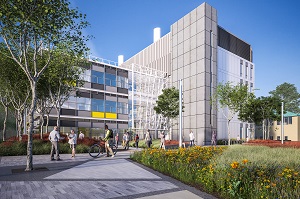£50m Health & Life Sciences Building gets planning approval
04 April 2017

Plans to build a new £50m Health & Life Sciences facility at the University of Reading have been approved by Wokingham and Reading Borough Councils.
Both councils approved the full planning application for a four storey building; the creation of a new entrance and external works to the Philip Lyle Building; and associated landscaping and car parking at Whiteknights campus.
The new building will provide a purpose-built teaching and research facility for the School of Biological Sciences, and a new flexible design will enable labs to teach groups of up to 280, making it one of the largest teaching labs in the UK.
Colin Robbins, Director of Estates and Facilities said:
“We are pleased to receive planning permission to create a new home for our life sciences work, and we are grateful to Wokingham and Reading Borough Councils for the go ahead.
"The project forms part of our ambitious capital investment programme 2026: TRANSFORM. Once the new building is completed, we will be redeveloping other parts of the Whiteknights Campus to continue to provide the highest quality experience for teaching and research.”
Spanning four storeys, the new facility will provide 7,557m2 of lab and teaching space, and will feature two dedicated floors for wet and dry research laboratories catering for up to 95 academic researchers and 145 doctoral students. The new building will also become the new site of the Cole Museum of Zoology.
Professor Steve Mithen, Deputy Vice-Chancellor, said:
“The Health & Life Sciences building will provide a world-class suite of teaching and research facilities, enabling us to continue our tradition of outstanding teaching in biological sciences and pioneering research that addresses the global challenges in biomedical science.
“It is just one of several multi-million pound investments within our current building programme designed to sustain, and further enhance, Reading’s status as a world leading teaching and research intensive university".
Key features include:
<!--[if !supportLists]-->· <!--[endif]-->A range of teaching laboratories and seminar room
<!--[if !supportLists]-->· <!--[endif]-->A bioresource unit (BRU)
<!--[if !supportLists]-->· <!--[endif]-->Research laboratories and write-up areas
<!--[if !supportLists]-->· <!--[endif]-->Offices and open plan areas for academic and support staff
<!--[if !supportLists]-->· <!--[endif]-->New location for the Cole Museum of Zoology
<!--[if !supportLists]-->· <!--[endif]-->New café
<!--[if !supportLists]-->· <!--[endif]-->Uniting the School - currently hosted in six buildings spread across the Whiteknights campus – to enable more efficient use of space and resources, allowing greater collaboration in research
The new facility will be built on the site of the Engineering Building and construction of the new facility is anticipated to be complete by summer 2019. The existing Engineering Building is set to be demolished as part of the programme, alongside Knight and Harborne buildings and the AMS Tower.
